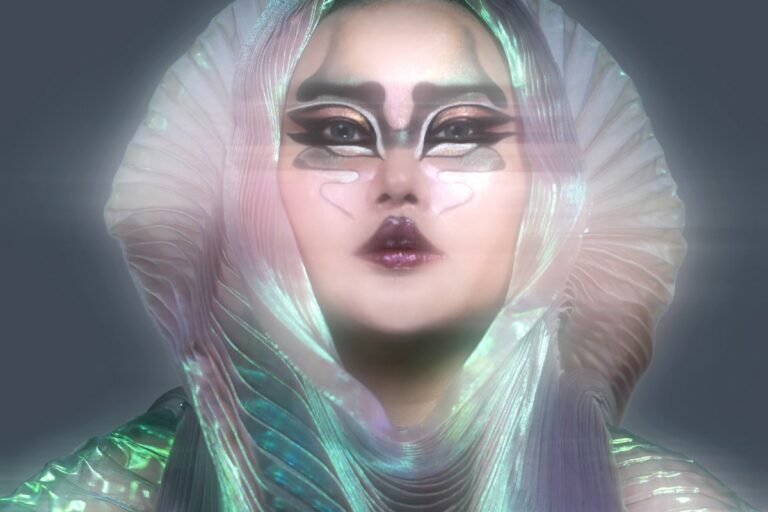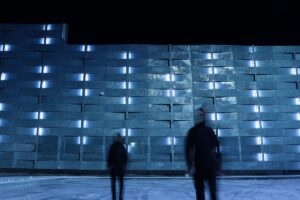I love music that takes me places. The best songs plunge my mind into emotional depths, open my ears to sounds I haven’t experienced before, and introduce me to new places and cultures.
CZARINA is an incredibly innovative artist whose music achieves all of that and more. She combines baroque textures, prog rock arrangements, massive synth riffs, and vocal acrobatics into a sound that’s wholly her own. Her adopted homeland of Galicia, Spain, and countless other influences from anime to astronomy provide an endless source of inspiration. CZARINA’s music is equal parts ethereal, expansive, and transportive—an immersive journey to realms of wonder and introspection.
In 2022, CZARINA released her sophomore album, Arcana, which I named the best synthpop album of the year. It’s packed with grandiose moments, like “Atomic: Ad Initivm,” which combines the vocal prowess of Sarah McLachlan with mystical flourishes and stabbing electronic pulses.
Today marks the start of a new era for CZARINA with the release of her third album, Empire. Preceded by the fiery singles “Exoskeleto” and “Ghost Machine,” Empire expands upon the cinematic, otherworldly soundscape she created with Arcana.
I reached out to CZARINA to learn more about how Empire advances her signature sound and how she harnesses her boundless creativity. Here’s what she told me.
Arcana felt like an artist discovering this incredibly groundbreaking sound. What did you want to achieve with its follow-up?
Arcana is quite earthbound and celebrates the grandeur of nature in its mystical, folkloric, and cosmic themes.
The follow-up, Empire, looks further up into the cosmos and outer space, drawing inspiration from science fiction, with references to the vastness of space and how it tends to mirror the depths of human consciousness and psyche. Empire is immersed in introspection, with a more futuristic vibe and a cerebral approach in the songwriting and production, while retaining the sound DNA established in Arcana.
You introduced so many unique songwriting techniques on Arcana—from the rhythmic chanting to Latin lyrics to proggy arrangements. What new songwriting or production techniques did you explore on Empire?
Arcana certainly had a lot of athleticism in the techniques, and I think I intended it to be so as I was still establishing my sound at the time. As Empire is supposed to play both like an outer space and out-of-body journey, a lot of the focus this time is achieving a certain type of transportive liminality in the vibe, energy, and delivery.
There’s a greater focus on sound design, textures and palettes, experimenting with cinematic drones, juxtaposing ethereal sounds with metallic machinery and electronics, and a much more robust dynamism and intricacy in the writing and arrangements.
Even though Empire is a slightly different exercise from Arcana, they both share the complex, proggy odd meters and polyrhythmic techniques, as well as spectral vocal harmonics that are signature to this project. However, Empire carries more mathematical and machine-like qualities—most evident in the orchestral sections of “Dark Star,” tracks like “Ghost Machine,” “Alchemy,” and the use of the Fibonacci sequence in “Metatronica,” which is quite the “meta” song where the composition, lyrics, and production directly match the intent and meaning behind the song’s concept.
Your music draws from a wide range of influences, including Greek mythology, anime, astronomy, even physics. Were there any specific inspirations that played a big role on Empire?
Yes, lots of outer space sci-fi themes from transhumanism, cybernetics, spacetime theories, quantum mechanics, to alien life forms. I went back to my love for animes like “Ghost In The Shell,” “Akira,” robotechs like “Gundam,” “Evangelion,” and films like “Aliens,” “The Abyss,” and “Interstellar.”
Empire in many ways is a bit of a love letter to my nerdy younger self, which allowed me to go back to things I loved when I was a kid. The music video for the title track, “Empire,” showcases this form of homecoming and the revival of things that were once lost in time.
Your music often feels otherworldly, and Empire literally is. The track “Beyond The Veil” incorporates samples of Saturn’s rings. From a production standpoint, how did you approach this?
I was very lucky to be able to borrow the recordings of Saturn’s rings that my dear friend, sound artist, and scientist China Blue discovered and captured for NASA. As soon as I got the recordings from her, I started building the track using the recording as a foundation, and I started layering the bass arpeggios, the moody piano work, sound designs, vocal effects on top.
It’s one of those rare occasions where the samples actually inspired and drove the composition, lyrics, and production. It all just flowed and came together, and I thought it would be quite magical to end the record with the sound of Saturn’s rings.
From the costumes to the locations, your videos are incredibly cinematic and immersive. Can you walk us through your creative process for developing the visual world of a song?
Music videos are so fun to work on and are a huge part of this project, even though they’re the most challenging and most meticulous since the majority of them are done at nearly zero budget and often just by me and my husband, the artist DeadlyKawaii. Our dog helps us sometimes.
Once in a while, I’ll save up for a bigger production with an actual film crew. But I find it’s more satisfying when it’s all DIY. We love the challenge. Sometimes I think we end up making it so hard on ourselves because we get so obsessed with introducing a new visual code.
For each music video, I usually start with a very thorough concept board, art direction, treatment, and a storyboard with the flow and edit of story, the list of all possible filming locations, and the specs for the costume design and props—the majority of which we create ourselves or repurpose from what we already have in our closets. My husband and I decide on the cinematography together, pulling references from movies we both love, then listing out all the gear and technical elements needed to execute the shots.
Depending on the complexities, filming could take anywhere from two to five days, and as we usually film outdoors using drones, we are always at the mercy of the weather. I do the actual editing, then my husband and I work together on CGI, special FX, and coloring. A music video typically takes anywhere from four to six weeks total to put together, depending on how massive and intricate the production is.
Galicia is stunning. After seeing your videos, I want to visit! How did you discover this magical place and end up living there?
Costa Da Morte in Galicia is one of my husband’s ancestral homelands. He was born and raised in London but has deep roots and family in Galicia and used to spend every summer in Costa Da Morte. He always wanted to permanently move here.
We were living in New York City when the pandemic hit and brought so many uncertainties and so many unknowns. We decided to take a leap of faith, uproot our lives and just go for the dream and move. It was the best decision we’ve ever made.
Galicia completely changed me and my perspective in life. Along with the epic, magical landscapes, the gastronomy is incredible. Yes, come visit. I encourage everyone to come and experience the magic for themselves. And I’m glad that many have shown interest when they see the music videos.
Finally, we joked before about how hard it is to pigeonhole your music into traditional genre categories. When someone asks what kind of music you make, how do you describe it?
I think the closest description so far is progressive darkwave and orchestral dark ethereal. It’s a lot of words, but I think those two descriptors encompass the full spectrum of the sound and vibe.
My neighbor recently said it’s like “Depeche Mode meets Princess Mononoke,” and that absolutely made my day! Though with Empire, we find Princess Mononoke waking up as a cyborg and piloting a mobile suit Gundam in outer space instead of riding a giant wolf in the forest.






